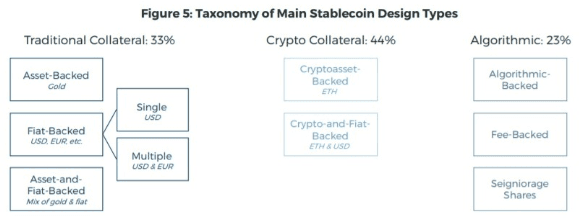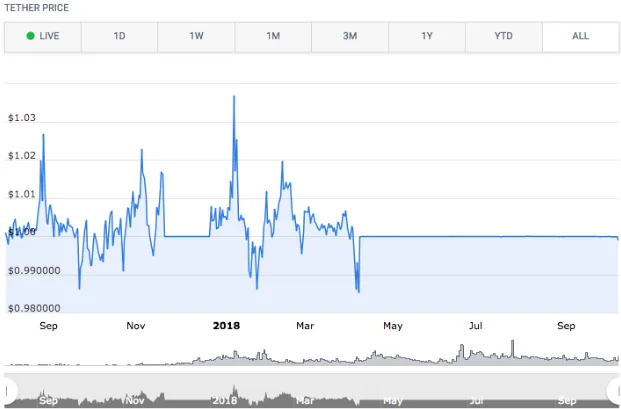Bitcoin and nearly all other cryptocurrencies are infamously volatile, capable of experiencing double-digit price swings in less than 24 hours. While this is an attractive feature for speculators looking to profit from price movements, it also remains one of the biggest barriers to the widespread adoption and legitimacy of cryptocurrency.
Enter stablecoins. These fixed-price digital currencies provide stability and a much wider range of everyday use cases than cryptocurrencies currently enjoy, and there are now more than 50 stablecoin projects being developed around the world.
Keep reading to find out how stablecoins work, the benefits they offer and why they’re important.
What are stablecoins?
A stablecoin is a cryptocurrency with a fixed price. While the price of most cryptocurrencies is determined by supply and demand, stablecoins are designed to achieve a constant, stable price.
The most common method stablecoins use to achieve price stability is to peg the value of their coin to a real-world asset, for example gold or the US dollar. However, there are also a couple of other approaches for designing stablecoins, and we’ll explore all the options in detail a little further down the page.
Compare stablecoins side-by-side
Coin name |
Issued by |
Launched |
Type of stablecoin |
Features |
|---|---|---|---|---|
AAA Reserve |
Arc Fiduciary Ltd |
2017 |
Fiat backed |
Backed by cash, gilts and AAA-rated credit investments |
AUDRamp (AUDR) |
OnRamp Technologies |
2018 |
Fiat backed |
Backed by and pegged to AUD |
A-Euro |
Augmint |
Not yet launched |
Crypto backed |
Pegged to EUR and backed by ETH |
Bridgecoin (BRC) |
Sweetbridge |
Not yet launched |
Fiat backed |
To be backed by fiat, crypto, IPs, physical assets and more |
Basis |
Basis |
Not yet launched |
Seigniorage shares |
Prices kept stable by algorithmically adjusting supply |
BitUSD (BITUSD) |
BitShares |
2014 |
Crypto backed |
Backed by BTS and pegged to USD |
Boreal |
Aurora |
Not yet launched |
Crypto backed |
Backed by ETH and various cryptocurrencies |
CarbonUSD |
Carbon |
Not yet launched |
Seigniorage shares |
Coin supply algorithmically adjusted based on demand. Pegged to USD |
Digix Gold Token (DGX) |
Digix Global |
2018 |
Fiat backed |
Backed by gold. Each token represents 1g of gold |
MakerDAO |
2017 |
Crypto backed |
Backed by ETH and pegged to USD |
|
EURS |
STASIS Foundation |
2018 |
Fiat backed |
Backed by and pegged to EUR |
eUSD (EUSD) |
Havven |
2018 |
Crypto backed |
Backed by ETH and pegged to USD |
μFragments |
Fragments |
Not yet launched |
Seigniorage shares |
Pegged to USD. Supply inflates and deflates in response to demand |
Gemini Dollar (GUSD) |
Gemini |
2018 |
Fiat backed |
Backed by and pegged to USD |
Globcoin (GLX) |
RCS |
Not yet launched |
Fiat backed |
Pegged to a basket of 15 fiat currencies and gold |
HelloGold (GOLDX) |
HelloGold Sdn Bhd |
2017 |
Fiat backed |
Backed by gold. Each token represents 1g of gold |
kUSD (KUSD) |
Kowala |
Not yet launched |
Seigniorage shares |
Pegged to USD. Supply expands and contracts depending on market conditions |
Monerium |
Monerium |
Not yet launched |
Fiat backed |
Backed by USD, EUR and other currencies |
NOS (Nollar) |
NOS |
Not yet launched |
Fiat backed |
Backed by EUR, pegged to USD/other fiat currency |
nUSD (NUSD) |
Havven |
Crypto backed |
Backed by nomins (Havven’s native currency) and pegged to USD |
|
Paxos Standard (PAX) |
Paxos Trust Company |
2018 |
Fiat backed |
Backed by and pegged to USD |
Rockz |
Fiat backed |
Backed by CHF |
||
Saga (SGA) |
Saga Foundation |
Not yet launched |
Fiat backed |
Pegged to the International Monetary Fund's special drawing rights (SDR), which is in turn tied to an underlying basket of currencies |
StableUSD |
Stably Blockchain Labs |
Not yet launched |
Fiat backed |
Backed by and pegged to USD |
Stronghold USD |
Stronghold |
2018 |
Fiat backed |
Backed by and pegged to USD |
SwissRealCoin |
SwissRealCoin |
2018 |
Fiat backed |
Backed by a portfolio of Swiss commercial real estate |
Terra |
Terraform Labs |
Scheduled for Q4 2018 |
Seigniorage shares |
Price stability ensured by algorithmically expanding and contracting supply. Backed by Luna, Terra’s own asset |
Tether |
2014 |
Fiat backed |
Backed by and pegged to USD |
|
TrueUSD (TUSD) |
TrueCoin LLC |
2018 |
Fiat backed |
Backed by and pegged to USD |
USD Coin (USDC) |
Circle |
2018 |
Fiat backed |
Backed by and pegged to USD |
USDVault |
Vault |
2018 |
Fiat backed |
Backed by gold and pegged to USD |
White Standard |
The White Company |
2018 |
Fiat backed |
Pegged to USD |
X8Currency |
X8 Currency |
2018 |
Fiat backed |
Backed by eight fiat currencies and gold |
How do stablecoins work?
How do stablecoin creators achieve the price stability they desire? There are three different types of stablecoins, each with its own approach for ensuring minimal price fluctuations.

Why are stablecoins important?
While Satoshi Nakamoto’s vision for bitcoin was as a form of electronic cash, the world’s biggest cryptocurrency is rarely used as a medium of exchange on a day-to-day basis. Rather, its volatility and high fees mean that bitcoin is impractical for everyday transactions, and is instead used more as a store of value.
The same can be said for most other digital currencies. Because prices fluctuate significantly from one day to the next, holding and using crypto in the same way you do Canadian dollars (getting paid a salary, paying for groceries, buying a coffee etc.) simply isn’t viable. Think about it – why would a business accept bitcoin as payment when 1 BTC might be worth $10,000 today, but tomorrow its value could have dropped to $9,000?
And this is, in theory at least, where stablecoins offer a key advantage. Not only do they offer all the benefits of cryptocurrency, including cryptographic security and the ability to transfer value digitally, but they’re designed to have the low volatility for which fiat currency is famous. The end result is a digital currency that can theoretically be used as a daily medium of exchange in the real world.
Stablecoin uses
What can stablecoins be used for? A price-stable cryptocurrency could potentially have a wide range of purposes, including:
- Medium of exchange. A successful stablecoin could be used as a medium of exchange for everyday spending in the same way we currently use Canadian dollars.
- Protection against market volatility. When the crypto market is experiencing a downturn, shifting your money out of traditional digital currencies and into a stablecoin can help hedge against market volatility. This can be particularly useful if you use a crypto exchange that doesn’t support fiat currency.
- Financial products. Stablecoins could potentially form the basis for a new financial ecosystem, including everything from crypto-backed loans and global remittances to insurance, as they provide the long-term stability required for many financial functions.
- Prediction markets. If you place a bet on the outcome of an event with a long timeframe, using a stablecoin allows you to minimize the impact of market volatility.
- Global access to a stable currency. In countries where the local currency is plagued by hyperinflation, holding a decentralized stablecoin could allow people to protect their wealth.
Bottom line
There’s little doubt that a working, trusted stablecoin is a key stepping stone on cryptocurrency’s path to mainstream acceptance. However, this goal is still some way off.
There have been numerous examples in recent years of stablecoin projects that have simply failed to stand the test of time. Even Tether, the world’s largest (in terms of market cap) stablecoin and one that’s been around since 2015, has been plagued by accusations that it doesn’t have sufficient US dollar reserves to back up the amount of USDT in circulation.
In The State of Stablecoins, a report from wallet provider Blockchain released in September 2018, the authors summed up the current situation in the stablecoin market by saying:
“While there is a great deal of excitement surrounding stablecoins, the technology is still nascent and it is highly unlikely that the perfect stablecoin design exists at present; further experimentation (and innovation) is expected.”
While some stablecoins have been able to demonstrate short-term stability, only time will tell whether they’ve got the goods to provide long-term reliability. Until that happens, don’t assume that any cryptocurrency will be able to provide the same stability as good old-fashioned fiat currency. And if you’re thinking of putting any of your hard-earned cash into a stablecoin project, make sure you thoroughly research it first.
FAQs
Picture: Shutterstock
Disclosure: At the time of writing, the author holds ADA, ICX, IOTA, POWR and XLM.
More guides on Finder
-
Cryptocurrency for beginners
Your simple guide to the basics of crypto, including how it works and how to buy crypto.
-
How to buy Solana meme coins
A simple, step-by-step guide to trading Solana memecoins in Canada.
-
How to get a crypto debit card in Canada
Spending cryptocurrency in the real world is easier than ever. Here’s how to get a crypto debit card in Canada.
-
How to withdraw from Coinbase
Want to cash out on Coinbase? Find out how to withdraw cash and crypto from the Coinbase app.
-
Buy crypto with a credit card in Canada
Learn how to buy cryptocurrency with a credit card and which exchange platforms accept credit card payments.
-
How to withdraw funds from Binance Canada
Find out what to do if you’ve been affected by Binance’s withdrawal from Canada.
-
What are the best AI crypto coins to buy in Canada?
Compare top AI cryptocurrency coins based on overall market capitalization and volume.
-
Ethereum (ETH) Price Prediction 2025, 2030 & 2035: April 2025 Report
A panel of industry specialists give us their predictions on the price of Ethereum to 2035.
-
Cardano (ADA) price prediction November 2024
A panel of industry specialists give us their predictions on the price of ADA to 2030.
-
Litecoin (LTC) price prediction November 2024
A panel of industry specialists give us their predictions on the price of Litecoin to 2030.

